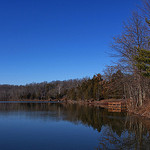Key information for official sites with agreements:
- Camp High Road is open unless specified on Camp High Road specific page
- C.M. Crockett is open only during periods specified on the Crockett specific page
- Meadowkirk observing requires explicit permission. See Meadowkirk page for details
- Sky Meadows State Park is open for vetted volunteers only unless posted on the Sky Meadows specific page
- Spruce Knob Mountain Center: See site specific page or contact site coordinator for availability
The first quarter moon should set just after midnight leaving dark skies for what could be a good show. Best viewing will be just after midnight from a dark location far away from city lights.
Also, check out the conjunction of Jupiter and Saturn, which will appear as if they are a single body!
The Ursids is a minor meteor shower producing about 5-10 meteors per hour. It is produced by dust grains left behind by comet Tuttle, which was first discovered in 1790. The shower runs annually from December 17-25. It peaks this year on the the night of the 21st and morning of the 22nd. Meteors will radiate from the constellation Ursa Minor, but can appear anywhere in the sky.
This marks the beginning of winter (in the northern hemisphere) and the beginning of summer (in the southern hemisphere.) The winter solstice is the shortest day of the year, respectively, in the sense that the length of time elapsed between sunrise and sunset on this day is a minimum for the year. Of course, daylight saving time means that the first Sunday in April has 23 hours and the last Sunday in October has 25 hours, but these human meddlings with the calendar and do not correspond to the actual number of daylight hours.
If you live in the southern hemisphere, this is your Summer Solstice, and good cause for celebrating the longest day of the year.
Speaker: Dr. Lucas Tarr of the National Solar Observatory

